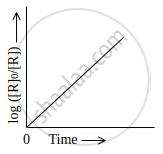Advertisements
Advertisements
प्रश्न
Show that for a first order reaction half life is independent of initial concentration.
उत्तर
For a first order reaction, the half life is a constant i.e., it does not depend on the initial concentration.
The rate constant for a first order reaction is given by,
k = `2.303/"t" log (["A"_0])/(["A"])`
at t = `"t"_(1/2)`; [A] = `(["A"_0])/2`
k = `2.303/"t"_(1/2) log (["A"_0])/((["A"_0])/2)`
k = `2.303/"t"_(1/2) log (2)`
k = `(2.303 xx 0.3010)/"t"_(1/2)`
k = `0.6932/"t"_(1/2)`
`"t"_(1/2) = 0.6932/"k"`
APPEARS IN
संबंधित प्रश्न
The integrated rate equation for first order reaction is A → products
The experimental data for decomposition of N2O5
\[\ce{2N2O5 -> 4NO2 + O2}\] in gas phase at 318K are given below:
| t/s | 0 | 400 | 800 | 1200 | 1600 | 2000 | 2400 | 2800 | 3200 |
| 102 × [N2O5]/mol L−1 | 1.63 | 1.36 | 1.14 | 0.93 | 0.78 | 0.64 | 0.53 | 0.43 | 0.35 |
- Plot [N2O5] against t.
- Find the half-life period for the reaction.
- Draw a graph between log [N2O5] and t.
- What is the rate law?
- Calculate the rate constant.
- Calculate the half-life period from k and compare it with (ii).
In a first-order reaction A → product, 80% of the given sample of compound decomposes in 40 min. What is the half-life period of the reaction?
The rate constant for a first order reaction is 1.54 × 10−3 s−1. Calculate its half life time.
Which radioactive isotope would have the longer half-life 15O or 19O? (Given rate constants for 15O and 19O are 5.63 × 10–3 s–1 and k = 2.38 × 10–2 s–1 respectively.)
Observe the graph shown in figure and answer the following questions:

Write the relationship between k and t1/2 (half-life period)
A reaction has a half-life of 1 min. The time required for 99.9% completion of the reaction is ______ min.
(Round off to the nearest integer).
[Use: In 2 = 0.69; In 10 = 2.3]
Show that the half-life of zero order reaction is `t_(1/2) = ([A]_0)/(2k)`.
Calculate the half-life of a first order reaction from the rate constant given below:
2 min−1
Calculate the half-life of a first order reaction from the rate constant given below:
4 year−1
